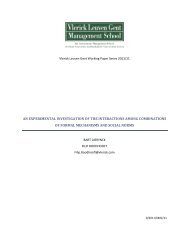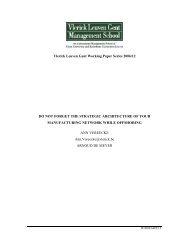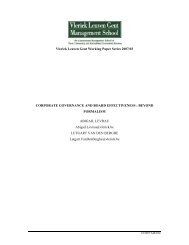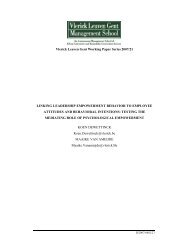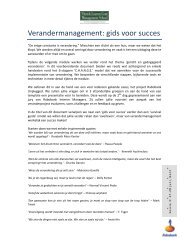innovation and internationalization by indian firms - Vlerick Public
innovation and internationalization by indian firms - Vlerick Public
innovation and internationalization by indian firms - Vlerick Public
You also want an ePaper? Increase the reach of your titles
YUMPU automatically turns print PDFs into web optimized ePapers that Google loves.
there were still a range of restrictions imposed <strong>by</strong> regulation <strong>and</strong> the firm-level capabilities. For<br />
example, restrictions on foreign exchange <strong>and</strong> hence overseas investments were still prevalent,<br />
along with redundant inefficiencies built up during the decades of the license raj. These barriers<br />
made market-seeking <strong>innovation</strong>s relatively few, <strong>and</strong> with even more limited cases of success in<br />
international markets. In the second phase, however, <strong>innovation</strong> picked up, <strong>and</strong> the further opening<br />
up <strong>and</strong> liberalization of the Indian economy meant that <strong>internationalization</strong> had a different<br />
character. We elaborate on this below.<br />
Phase Two (2000 to 2005): Innovation for the Indian Market<br />
The second phase of our analysis broadly corresponds to the years 2000 to 2005. In the first<br />
phase, Indian <strong>firms</strong> were still emerging out of a protected environment <strong>and</strong> the sense of entitlement<br />
that entry barriers created <strong>by</strong> regulation confers. However, through the 1990s, as the Indian<br />
economy liberalized <strong>and</strong> a different set of institutional conditions set in, Indian <strong>firms</strong> developed<br />
towards operating in more competitive conditions. In 2000-2005 then, <strong>innovation</strong> trajectories <strong>and</strong><br />
<strong>firms</strong>’ focus shifted from the transient advantages afforded <strong>by</strong> labour <strong>and</strong> cost arbitrage as both the<br />
environments <strong>and</strong> <strong>firms</strong>’ strategies changed.<br />
While there were some uncertainties in Phase One on whether the opening up of the Indian<br />
economy was going to be transient, during Phase Two it became increasingly clear that the<br />
liberalization process was largely irreversible. The philosophy of the Indian state in managing the<br />
Indian economy had clearly changed from active participation to providing the context within which<br />
private <strong>firms</strong> could grow <strong>and</strong> prosper. Further, many restrictions, such as those on capital <strong>and</strong><br />
foreign exchange transactions, were relaxed, as the Indian economy gradually became more<br />
integrated with the global economy. Hence, M&A emerged as a viable strategy for Indian <strong>firms</strong><br />
looking to gain globally competitive innovative capabilities.<br />
Competitive conditions too became more intense across a range of industries, as more were<br />
opened up to both domestic <strong>and</strong> foreign competition. Many Indian <strong>firms</strong> radically restructured in the<br />
late 1990s <strong>and</strong> early 2000s, as they shed peripheral businesses <strong>and</strong> increased focus (Luce, 2008).<br />
While in the past, the philosophy of many Indian <strong>firms</strong>, <strong>and</strong> business groups in particular, was that<br />
‘we can do anything <strong>and</strong> everything’, the philosophy in the 2000s became more focussed within<br />
sometimes related fields (for instance, oil, gas & refining for the Reliance group, or the industry<br />
sector approach of the Birla group).<br />
As Indian companies became more efficient <strong>and</strong> as new <strong>firms</strong> entered, the Indian economy<br />
as a whole started to pick up speed. Economic growth in the 2000s put India on the world map, <strong>and</strong><br />
made it one of the more attractive emerging markets, along with the other BRICs. This offered<br />
8



